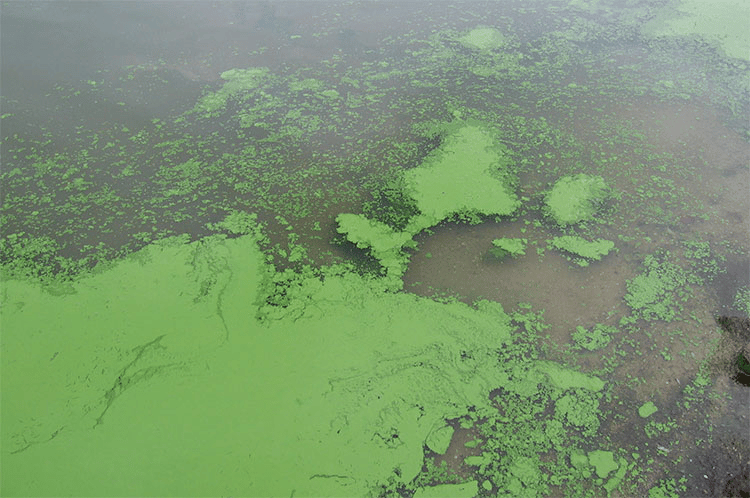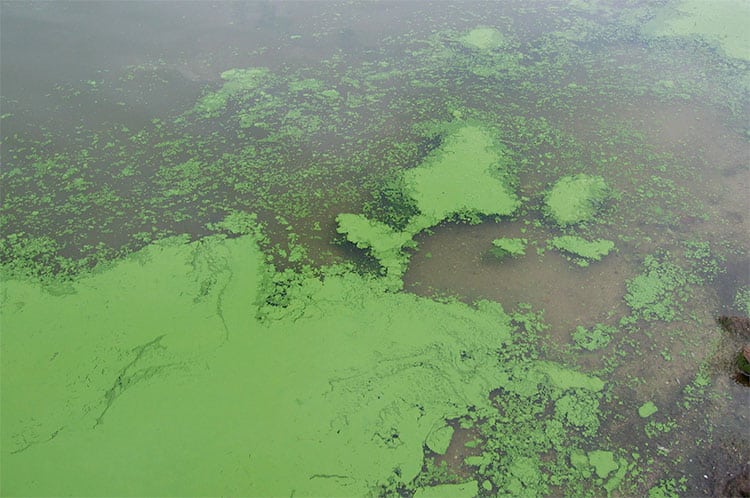• by Dr. Sarah Oktay, Director, University of Massachusetts Nantucket Field Station •
Every summer two dangers come floating to the surface, one entertaining but unlikely, the anticipated and much feared great white shark attack, the other much less entertaining and sadly, very likely, in the form of blue green algae blooms infecting our ponds and in the case of Toledo, Ohio, drinking water supplies. This summer the social mediaverse is flooded by Sharknado 2: The Second One, an attempt to expand on the campy “straight to TV” SyFy movie combining tornados and sharks into one big crazy disaster film. Our burgeoning gray seal population has brought in more great white sharks and increased awareness about their populations and every week we see a news story on shark tagging and the presence of sharks. In the next week or two we will explore some of the recent information on sharks in the area. Also dominating the news is the recent cyanobacteria or blue green algae outbreak in western Lake Erie which has reached the drinking water supply for 500,000 residents in Toledo Ohio. It is extremely rare for a large municipality to issue a state of emergency alert warning residents not to use the water due to bacterial contamination of this sort. Boiling only release more toxins, so until the levels of neurotoxins has dissipated, residents are forced to drink bottle water and should limit their exposure. Sadly, here on Nantucket, Hummock Pond has been wrestling with this same issue for the past several years.

The real dangerous “creature” floating in one of our local ponds is the size of a pin head or smaller and appears as a bright, bluish-green sheen on the water. I am talking about a couple of cyanobacteria species, also known as blue-green algae, which form large algae blooms if given an opportunity due to a “perfect storm” of human use and nature’s rains. The type of blue-green algae species measured over the past five plus years in Hummock Pond can be lethal to dogs and pose a health hazard to humans too, and in this case, are more common than our big-jawed friend, the great white shark. These outbreaks of harmful algae blooms occur when an overabundance of food in the form of nutrients from fertilizers and other sources is washed into ponds after large rainfall events. Each year the Nantucket Land Council with excellent science guidance by Dr. Jim Sutherland, the Nantucket Biodiversity Initiative scientist Pia Moisander from UMass Dartmouth, and the UMass Boston Nantucket Field Station fund or conduct studies to look at the various inputs into the pond and resulting chemical and physical characteristics. As in all scientific problems, first you need to identify the problem, find some possible causes, investigate the causes, and then work on solutions. A person trained to look at these samples under a microscope can easily identify the offending parties which are often Microcystis aeruginosa and Anabaena circinalis (more about those below). Both species produce dangerous neurotoxins that are considered toxic to humans, dogs and livestock.
Let’s back up a bit and learn more about cyanobacteria which are blue-green bacteria members of Cyanophyta, a phylum of bacteria that obtain their energy through photosynthesis. The name “cyanobacteria” comes from the color of the bacteria, from the Greek word “kyanós” for “blue”. They are a significant component of the marine nitrogen cycle and an important primary producer in many areas of the ocean, but are also found in habitats other than the marine environment; in particular cyanobacteria are known to occur in both freshwater and in hypersaline inland lakes and in arid areas where they are a major component of biological soil crusts. The ability of cyanobacteria to perform oxygenic photosynthesis is thought to have converted the early reducing atmosphere into an oxidizing one, which dramatically changed the composition of life forms on Earth by provoking an explosion of biodiversity and leading to the near-extinction of oxygen-intolerant organisms. So without these bacterial species, we would not be here.
But some days that which gives you life turns around and makes itself a nuisance or a danger. One bacterial (microbial) species we are on the lookout for is a common one in these bright green surface algae blooms and it is called Microcystis aeruginosa. It grows readily in nutrient-rich, slowly moving water. In most bodies of fresh water and most weather conditions, Microcystis aeruginosa does not pose a hazard to wildlife or human beings. However, under certain conditions such as when the water is warm with abundant nutrients Microcystis aeruginosa can grow more rapidly than normal. The result can be large colonies that form floating masses on the water; they look like huge swaths of green paint and often exude a foul or musty odor. Under these conditions, Microcystis aeruginosa can produce natural toxins (called microcystins) that are very potent. The microcystin toxins are produced and contained inside the Microcystis cells, and are released to the water when the cells die and disintegrate. Since the cells are very small, they can be ingested along with the water. Toxin levels in a water body tend to be higher near shorelines and at the surface of the water where animal and human contact is most likely.
Aside from being a nuisance and a danger to fish and wildlife, a bloom of Microcystis aeruginosa may be harmful to humans during recreational water use, either through body contact, inadvertent ingestion, or inhalation of water droplets. Body contact during water recreation may lead to minor skin irritations or allergic reactions of skin, including eye irritation and blistering of the lips. On a more serious level, inadvertent ingestion or inhalation of Microcystis aeruginosa may, within several hours after exposure, lead to abdominal cramps, nausea, vomiting, diarrhea, fever, sore throat or hay fever-like symptoms, with recovery within 48 hours. Fun times!
As would be expected, the risk of developing these adverse reactions increases as the intensity of the bloom increases. It is also characteristic of these blooms to wax and wane from day to day. Given these facts, it is reasonable for public health authorities to post an advisory cautioning against swimming in water where a bloom is readily visible rather than outright closure of the beach for all activities. However, it is important to keep in mind that very young children may be at higher risk than older persons. It may take as long as three weeks for the toxins to drop to a safe concentration. Fortunately this year we have not had a big algae outbreak in the lower end of Hummock Pond yet. A few weeks ago a 2-3 day bloom occurred in the Head of Hummock Pond off Millbrook road that dissipated quickly in rain and cloudy windy conditions. The people of Toledo Ohio are not so lucky. The huge blooms occurring in western Lake Erie are exacerbated by shallow water, sunny days, a large watershed and multiple sources of pollution from large factory farms to feedlots to lawns,
The big problem from blue green algae doesn’t occur until it dies and lyses or splits in pieces, forming and releasing toxins as it dies. Blue-green algae produce three types of toxins: neurotoxins, hepatotoxins, and dermatoxins (skin irritants). Neurotoxins affect the nervous system. Symptoms include muscle cramps, twitching, and in extreme cases paralysis, cardiac or respiratory failure, and death. Hepatotoxins (like microcystins) affect liver function. Symptoms include nausea, vomiting, diarrhea and, in extreme cases, even acute liver failure. The World Health Organization (WHO) has established a health-based drinking water guideline of 1.0 ppb for one algal toxin, Microcystin-LR.
Pets and livestock are especially susceptible to the toxic effects of microcystin. For example, in Nebraska in May of 2004, three dogs died shortly after swimming and presumably drinking the water in a private, residential lake with an algal bloom; subsequent analysis of the lake water and tissue specimens indicated that microcystin caused those deaths. Other scientific papers over the past ten years have corroborated this effect, so please keep your dogs out of posted areas. Deaths in livestock have also been reported in the scientific literature, particularly where droughts may induce animals to drink algae-contaminated water when fresh water is not readily available. Human beings are likely to experience serious illness from drinking water containing large concentrations of microcystin, but it is important to note that wells nearby are safe.
The best way to stop these blooms from happening? Keep excess phosphorus from lawns, gardens and farms out of the ponds. Our new Best Management Practices (BMP) for the island recommends that no phosphorus be used in any fertilizer unless a soil test shows it is needed. We already have plenty of phosphorus in our sandy soil and excess is not used by the plant and goes straight to the shallow groundwater. Organic fertilizer should also be used sparingly and should contain low phosphorus. Manure may contain a lot of phosphorus so just because something is organic doesn’t mean you should go to town using it. Look at the shampoos and detergents you use and make sure those are low in phosphorus. More about our BMP can be found here: http://www.nantucket-ma.gov/DocumentCenter/Home/View/437. The document includes some excellent material on the many sources of phosphorus. Many factors figure into bloom events in addition to the excess nutrients making their way to the pond: large rainfall events, very sunny days that provide plenty of light to the algae and set up a thermocline preventing circulation and our warming climate all contribute to increasing bloom events. The Town of Nantucket, specifically the Natural Resources Department and the Nantucket Land Council along with area Civic Associations located around ponds like Hummock Pond are doing a variety of things to address the problem. And here at the UMB Nantucket field station, we have been testing Nantucket ponds for phosphate and nitrate and other things for ten years. Currently we are testing new material called Opflex for Water Defense to see if it can detect contaminants and/or remove excess phosphorus. Stay tuned!
I find it beyond ironic, that something that seems so safe and at most just a noxious puddle can be a significant health risk while the odds of Jaws swallowing us whole off Surfside are probably in the 1-in-a-billion range. Either way, I hope you will stay safe and still enjoy the summer. Swim in the ocean and admire the ponds and enjoy each day.
I decided this week to put all the references I enjoyed that you might find helpful at the end.
Nantucket pond summary for 2013: http://www.nantucket-ma.gov/DocumentCenter/Home/View/85
LA Times article on harmful alga bloom in Ohio: http://www.latimes.com/nation/nationnow/la-na-nn-toledo-ohio-toxins-water-20140802-story.html
A Primer on BG Algae from the EPA: http://www.epa.gov/greatlakes/lakeerie/primer.html
7 Things You Need To Know About the Toxin That’s Poisoned Ohio’s Drinking Water: http://thinkprogress.org/climate/2014/08/03/3467068/toledo-ohio-water-crisis/
NOAA predicts Lake Erie BG bloom: http://www.noaanews.noaa.gov/stories2014 /20140710_erie_hab.html
Portions of this article originally were published in 2009: http://yesterdaysisland.com/archives/science/13.php



